The Carcamp from Heku
Another interesting camper from German company, Heku, called the Carcamp really lives up to its name.
It sleeps FOUR people, believe it or (Continue Reading…)
Another interesting camper from German company, Heku, called the Carcamp really lives up to its name.
It sleeps FOUR people, believe it or (Continue Reading…)
Should you go tiny or huge? Luxurious or spartan?
When we were camping in Buckskin Mountain State Park last month, I was struck with the difference in size between our tent trailer and the motorcoach next to us. It made me wonder how my experience at the park compared with theirs and what each of us had to do to get there. So I made a comparison of my tent trailer to what I imagine for the motorcoach next to me. (Continue Reading…)
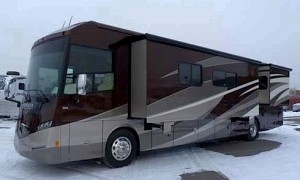 Motorhomes can range from anything to a van conversion to a massive motor coach. I was shocked the first time I arrived in Quartzsite because I thought only movie stars and musicians toured the country in huge motorhomes, but ordinary people all over this nation own HUGE motorhomes.
Motorhomes can range from anything to a van conversion to a massive motor coach. I was shocked the first time I arrived in Quartzsite because I thought only movie stars and musicians toured the country in huge motorhomes, but ordinary people all over this nation own HUGE motorhomes.
I’ve seen motorhomes in our classifieds for as low as $3,000, but they seldom have a running engine at that price. I appears that you have to spend at least $5,000 to get one that runs and more if you want any hope of it continuing to run. The new motorhomes are HORRENDOUSLY expensive with prices in the $200,000 to $500,000 range. I’ve even seen them as high as $1,000,000.
Fortunately, that’s where the expense ends. You don’t need a heavy-duty tow vehicle because a motorhome HAS an engine. You might want to tow your car behind the huge motorhome, which might cost you in the gear to make that happen, but once you’ve bought your motorhome and it runs properly, you don’t need another vehicle.
If you are a brilliant mechanic, then the thought of an old motorhome probably doesn’t frighten you, but to me, it’s terrifying. I much prefer to have my camping in a vehicle that doesn’t have an engine attached. Then, I can change my tow vehicle when the engine fails or change the camping vehicle when it gets old, leaky or worn out. I prefer my RVs to be interchangeable that way.
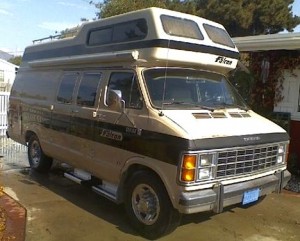 Just like a travel trailer and fifth-wheel, a motorhome would need a large piece of land for storage or a spot at an RV facility for $100-$120 a month. Very few motorhomes would fit under the low door clearances of a garage, not even this van conversion motorhome.
Just like a travel trailer and fifth-wheel, a motorhome would need a large piece of land for storage or a spot at an RV facility for $100-$120 a month. Very few motorhomes would fit under the low door clearances of a garage, not even this van conversion motorhome.
This is the worst of them all. Last year, at Quartzsite, I asked what mileage those big motorcoaches got and not one person answered higher than 7 mpg. The lowest was 2 mpg, but he had a glint in his eye when he told me and I don’t know if he was pulling my leg or not. The smaller motorhomes can get 12-15 mpg regularly, but you really have to watch the weight in your coach, drive 55 mph and keep your engine fine-tuned to get that good of mileage.
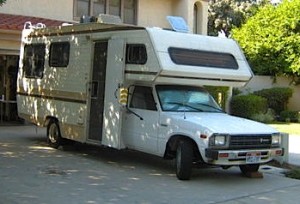 Motorhome sleeping capacity is as vast as the sizes of motorhomes. The tiny vans usually only sleep two, whereas this tiny Toyota Dolphin Motorhome can sleep six. The huge motorcoaches can sleep as many people as the biggest of the tent trailers.
Motorhome sleeping capacity is as vast as the sizes of motorhomes. The tiny vans usually only sleep two, whereas this tiny Toyota Dolphin Motorhome can sleep six. The huge motorcoaches can sleep as many people as the biggest of the tent trailers.
Just as with the sleeping capacity, the comfort levels can be spartan or luxurious. Most motorhomes have propane heaters. Some of them even have A/C. Since they are all hard-sided, they will definitely be warmer to sleep in than tent trailers, so those cold nights in the Utah mountains will be easily slept through in a motorhome.
Additionally, you have the comforts of your motorhome while you’re driving. Your spouse or children can wander the motorhome, getting food, playing with their toys or even sleeping while you drive. If you’re stuck in traffic, you can even switch drivers quickly. And the luxury of a restroom onboard would allow for fewer stops along the way if you didn’t have to refill the gas tank so often.
I imagine that setting up a motorhome at the campsite would be the easiest of all, especially if you’re not towing an additional vehicle behind you. I would think that parking and leveling would be all that you needed before you could drop into your pre-made bed to sleep.
The small van conversions might not have restrooms, but even some of them have them. I love the thought of having a restroom in a motorhome. I imagine Mike would be driving and I could just get out of my seat and use the bathroom while we were still going. It’s a luxury I can’t stop thinking about when considering a motorhome.
I have NO idea how people drive these huge motorhomes. We don’t hear about motorhomes getting blown over by huge winds on I-15 every year, but they do get into accidents quite frequently. I can’t even fathom how to drive them, but here is a video about how to drive.
I’m more partial to the smaller RVs just because I imagine they’d be easier to drive, but I really have no experience with them.
Just like with the travel trailers and fifth-wheels, there are some campsites in our national and state parks that are too short for the longest of the motorhomes. You’ll be safe as long as your motorhome is less than 25 feet, but most sites can accommodate motorhomes that are 25 feet or less.
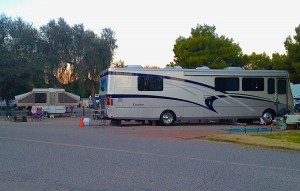 If you are in a luxury motorcoach, you won’t have any problems with elitism at luxury RV resorts like I have with my tiny tent trailer. I suspect if I had a tiny Toyota Dolphin motorhome, however, the people at that luxury resort would have put me in the back with tent trailers.
If you are in a luxury motorcoach, you won’t have any problems with elitism at luxury RV resorts like I have with my tiny tent trailer. I suspect if I had a tiny Toyota Dolphin motorhome, however, the people at that luxury resort would have put me in the back with tent trailers.
Depending on your motorhome, you might attract a crowd. I suspect that the older your motorhome is, the more likely you are to have strangers come to your campsite to talk to you and ask to see the inside.
The Walmart overnight parking benefits were MADE for motorhomes. They expect you to have engine trouble and need parts at their store and they would love you to stay there and spend your money. One note, however, is that it’s polite to not put down your stabilizers and leveling jacks.
I’ve never owned a motorhome, so my viewpoint might be a little off on these RVs. They may be harder to set up or easier to drive than I imagined. I’d be interested in using one for a few months to see how that would change my viewpoint, but at this juncture, it’s just not within my price range.
Here are links to the other entries in this series:
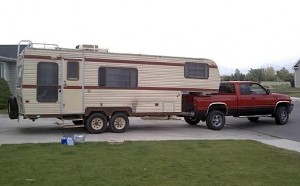 Fifth-wheel trailers look like travel trailers, but they have a large gooseneck at the front that attaches to a huge hitch on the bed of a pickup.
Fifth-wheel trailers look like travel trailers, but they have a large gooseneck at the front that attaches to a huge hitch on the bed of a pickup.
Used fifth-wheels can be found in the classifieds for as low at $800, but a good one will probably cost you about $2,000. New, they can go for as much as $50,000, so they can be very pricey if you want a brand new one.
Another cost you have to plan for is a pickup. You MUST have a pickup to tow a fifth-wheel. An SUV with a high towing capacity won’t work for you because you need to have the pickup bed to attach the trailer to your vehicle. If you already own a pickup and plan to continue owning one, then you’re set, but if you prefer any other car, you cannot tow a fifth-wheel with it.
Just like the travel trailers, a fifth-wheel trailers can’t just be easily stored in your garage. They are very high and won’t fit under a garage door. They won’t even fit under a drive-thru roof, as shown in this video (BTW the driver and his son escaped unscathed).
You’ll have to find a huge spot on your property to store it out in the elements or store it at an RV storage facility at $100-$120 a month.
My mom owns a fifth-wheel and a Toyota diesel truck. The truck gets 18 mpg when it’s not towing and 12 mpg when it is. You can assume it will take about 6-7 miles per gallon off your usual mpg.
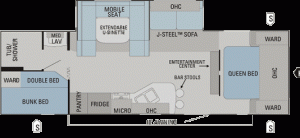 As huge as fifth-wheel trailers are, they don’t seem to sleep much more than tent trailers. My eight-foot tent trailer can sleep six, whereas my mom’s fifth-wheel can sleep six people. The difference is that there is a lot more room to move about in her trailer than there is in mine. Considering that their trailer is THIRTY feet long, I’m surprised that there isn’t sleeping capacity for twenty people in that thing. If fifth-wheel manufacturers used their square footage as efficiently as truck camper and tent trailer manufacturers, they WOULD be able to sleep twenty per trailer.
As huge as fifth-wheel trailers are, they don’t seem to sleep much more than tent trailers. My eight-foot tent trailer can sleep six, whereas my mom’s fifth-wheel can sleep six people. The difference is that there is a lot more room to move about in her trailer than there is in mine. Considering that their trailer is THIRTY feet long, I’m surprised that there isn’t sleeping capacity for twenty people in that thing. If fifth-wheel manufacturers used their square footage as efficiently as truck camper and tent trailer manufacturers, they WOULD be able to sleep twenty per trailer.
Fifth-wheel trailers are the epitome of comfort. Not only is there heat and A/C. There are refrigerators, microwaves and a plethora of other amenities. If you plan on living in your RV full-time or even half the year, a tent trailer would be a hardship. A fifth-wheel, on the other hand, would be like living at home.
Every time my mom and Reed go camping with us, I’m surprised at how long it takes them to set up. They don’t have to pull out bunk ends or raise the roof, but it usually takes them just as long to get their fifth-wheel into its spot, leveled and ready to go. I don’t know if that is added complexity on my mom’s part or if fifth-wheels are REALLY that time consuming to get into a campsite. Just watching this video from RV101 about how to hitch up a fifth-wheel makes me break out in a cold sweat.
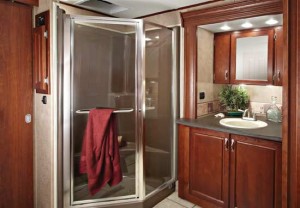 Yes, yes, a thousand times, yes! This is one place where fifth-wheel trailers really shine. I’ve seen the most beautiful bathrooms in fifth-wheel trailers that make the bathroom in my own house blush with inadequacy.
Yes, yes, a thousand times, yes! This is one place where fifth-wheel trailers really shine. I’ve seen the most beautiful bathrooms in fifth-wheel trailers that make the bathroom in my own house blush with inadequacy.
Fifth-wheel trailers are supposed to be safer to tow than bumper pull travel trailers, but they are BOTH very susceptible to wind. Every year in Utah, we have several fifth-wheels overturned on I-15 because of heavy winds. Considering that I’ve driven in wind storms such as these with my tent trailer and had NO problem, I’m very reluctant to trade it in for a trailer that is harder to tow under those conditions.
Additionally, the law doesn’t require RV owners to take any special classes to learn how to drive their monstrous vehicles. If you want to drive a fifth-wheel, you basically have to teach yourself how to drive a vehicle that’s as big as an 18 Wheeler. If that doesn’t scare you, then you’re a far better driver than I am.
In the national and state parks, you could run into troubles with some campsites not being long enough for your fifth-wheel. Many of them list their limitations, for example, 25 foot, on their websites, but sometimes you might show up at a campground, hoping you could stay there and find that your 30 foot fifth-wheel just doesn’t fit.
Additionally, a campsite might be long enough to fit your huge fifth-wheel, but getting it into its spot might be a geometrical nightmare. Trying to make your long trailer fit into your campsite might be possible, but only if you are a master driver.
At the luxury RV resorts, however, you won’t have that kind of problem. The resorts that specialize in pull-through sites and have beautiful landscaping will gladly welcome your fifth-wheel and maybe even put you in their lovely premium sites just because your camper is that nice.
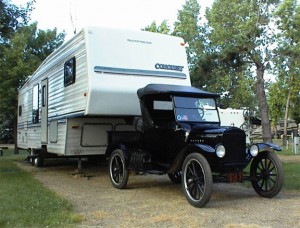 No one will think your fifth-wheel is weird. They won’t think it’s cool or come over and ask what it looks like inside. Since they are so commonplace, you will be camping in obscurity every time. You will have to make MAJOR modifications to your fifth-wheel or tow it with a strange tow vehicle to get any attention.
No one will think your fifth-wheel is weird. They won’t think it’s cool or come over and ask what it looks like inside. Since they are so commonplace, you will be camping in obscurity every time. You will have to make MAJOR modifications to your fifth-wheel or tow it with a strange tow vehicle to get any attention.
When Walmart offered to let campers stay overnight in their parking lots, fifth-wheels are the exact campers they had in mind. The only time a fifth-wheel trailer has been turned away is when the Walmart doesn’t allow overnight camping at all.
I’ve never owned a fifth-wheel trailer, so my viewpoint might be a little off on these RVs. They may be harder to level or easier to hitch up than I imagined. I’d be interested in using one for a few months to see how that would change my viewpoint, but at this time, I don’t have a vehicle to tow one nor the space to store it.
Here are links to the other entries in this series:
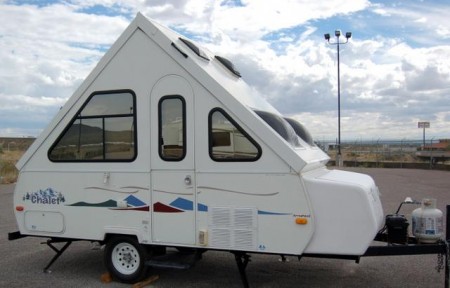 If you like the idea of a hard-sided travel trailer, but want to be able to store your camper in a garage, an A-Frame camper might be your best bet. They fold up flat like a tent trailer and lift up to a cute little cabin-style camper.
If you like the idea of a hard-sided travel trailer, but want to be able to store your camper in a garage, an A-Frame camper might be your best bet. They fold up flat like a tent trailer and lift up to a cute little cabin-style camper.
These kind of trailers are available from the following manufacturers:
Finding A-Frame campers used is almost impossible. When I do find them used, they aren’t amazing deals like I find with a tent trailer. They usually range in price from $6,000 to $25,000, which is almost as much as they cost new. They usually settle in the range of $10,000 to $15,000 for used.
The benefit of the A-Frame trailers is that you can tow them with smaller cars than travel trailers. We couldn’t quite tow one with our Prius, but most mini-vans and other six cylinder vehicles could handle them.
Just like a tent trailer, you can roll it into the garage for storage. Depending on the height, you might even be able to deploy it in the garage, like a tent trailer. If you don’t have space in your garage or on your property, then you’ll have to pay to store it at a facility for about $65-$100.
Towing an A-Frame will reduce your gas mileage by about five miles a gallon. skipnchar at RV.net Open Roads Forum said:
When I was towing a 2500 lb. pop up trailer with my Mazda B4000 I got 15 or 16 MPG towing and 19 or 20 running empty. Don’t know if this helps much or not but that’s about as good as I can do I would expect you’d find something similar (losing something like four or five MPG towing depending on the actual weight.
A-Frame trailers sleep far less people than comparably sized tent trailers. Most of them only sleep two people. Some of the floorplans can sleep four people if you fold down the dinette. If you want to sleep two adults and a child, but need some place for one of the adults to sit while the other and child sleep, then you are out of luck.
 The beauty of the A-Frame trailers is that almost all of them come with propane heat and A/C. The hard-sided walls keep in the heat WAY better than a tent trailer. Some people add Reflectix on the windows to insulate against the sun in the hot weather. I suspect that also works well in the winter to keep the heat escaping out the windows.
The beauty of the A-Frame trailers is that almost all of them come with propane heat and A/C. The hard-sided walls keep in the heat WAY better than a tent trailer. Some people add Reflectix on the windows to insulate against the sun in the hot weather. I suspect that also works well in the winter to keep the heat escaping out the windows.
Unlike a tent trailer, their setup is hilariously easy. Here is a quick video showing you how they work.
Some of them are more elaborate with dormers, so they take slightly more time to set up, but on the whole, you can get your A-Frame camper up and ready within five minutes.
A-Frame trailer bathrooms tend to be just like tent trailer bathrooms, where the toilet is out in the open unless you pull the paper-thin curtain for what acts as privacy. The only exception is Chalet, who has an origami bathroom that folds up nicely with a real door. Here is a video showing the setup of that trailer.
The Chalet XL 1938 is the only A-Frame trailer with a full sized bathroom with a real door. Here’s the floor plan.
Here’s a video showing one that was for sale. She has some trouble with her camera, so you’ll have to turn your head to the side to see parts of it, but it gives you a good idea.
Towing an A-Frame trailer is probably just as easy as towing a tent trailer. It is UNAFFECTED by strong winds and you can see over it out the rear window. Despite being slightly heavier than tent trailers, I suspect they are just as safe to tow.
Just like tent trailers, A-Frame trailers can fit into almost any campsite with no trouble. And I doubt you would run into any of the elitism that tent trailers experience at campgrounds because they are so unique that campgrounds will want to put them in the premium spots.
A-Frame campers are so new and rare, I suspect you’d have just as many people wanting to see it as I did with the teardrop camper. Additionally, I’d bet that setting up and breaking camp would become a source of entertainment to anyone in the campground just because everyone would want to see how they worked.
The marketing for A-Liner says, “It takes 30 seconds to set up and 30 minutes to answer all the questions from the other campers.” If you like this sort of attention, then an A-Frame is for you. If not, having one would be an embarrassing trip every time you camped.
Even though they have to pop-up, I bet you would have no trouble at Walmart with an A-Frame. They are hard-sided, so I suspect it would be easy to sleep. The only problem I could see is with the units that don’t have restrooms. You would have to stay at a 24 Hour Walmart or hold your bladder until they open up in the morning.
I’ve never owned an A-Frame camper, so my viewpoint might be a little off on these RVs. Their sleeping capacity is slightly smaller than I’d like and finding them used is rather difficult. I’d be interested in using one for a few months to see how that would change my viewpoint, but at this juncture, I don’t think an A-Frame is right for us.
Here are links to the other entries in this series:
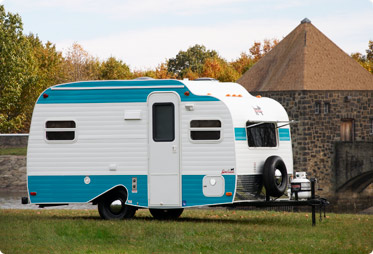 This category includes the adorable Canned Ham trailers of the Fifties right up to huge bumper pull trailers.
This category includes the adorable Canned Ham trailers of the Fifties right up to huge bumper pull trailers.
While you can find a used travel trailer for only $800, the cost to tow it must include a tow vehicle that can handle its weight and increased wind resistance. If you already own a huge pickup, then you’re doing just fine and will be able to find an inexpensive used trailer for about $1500 to $2000 that will last you for YEARS.
While it is possible to find many used travel trailers in the classifieds for a reasonable cost, a new travel trailer will cost you a minimum of $10,000 and that is for the smallest and most basic of units that will only sleep two people. If you have any more than two in your family, you will have to get a LOAN to afford your trailer.
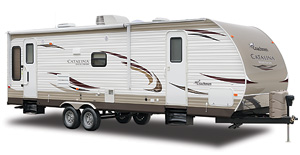 There is NO avoiding storage costs with a travel trailer if you don’t have a swath of property to put it on. They are too tall to fit into a normal garage, so they are almost always stored outside in the elements. Expect to pay quite a pretty penny to keep your travel trailer when you’re not using it. RV storage facilities usually charge between $100 – $120 a month to store an RV.
There is NO avoiding storage costs with a travel trailer if you don’t have a swath of property to put it on. They are too tall to fit into a normal garage, so they are almost always stored outside in the elements. Expect to pay quite a pretty penny to keep your travel trailer when you’re not using it. RV storage facilities usually charge between $100 – $120 a month to store an RV.
Towing a travel trailer not only eats up gasoline, you have to have a gas hog vehicle to tow it. Don’t expect to get more than 12 mpg and that’s with a diesel truck.
Strangely, you can usually sleep more people in a tent trailer than a travel trailer, but they usually can sleep at least four people. The least expensive trailers usually only sleep two, but I’ve seen travel trailers with sleeping capacity for 6-7 before.
Nothing beats a hard-sided trailer for comfort. Almost all campers have heaters that run on propane and some even have A/C units as well. There is room inside to change clothes and hide from the rain. Some of them even have separate rooms for the sleeping quarters for additional privacy.
All you do is back in, level out and connect to the water and electricity. I’ve never owned a travel trailer, but I suspect it takes only slightly more time than our teardrop did, as long as you know how to back up a trailer (that’s a tricky maneuver).
Not all, but MANY travel trailers have restroom and showers. That can complicate things because those facilities need to be emptied when they are used, but sometimes a little gross work is worth not having to walk to the vault toilets in the cold night.
There is always a risk of being blown off the road when you’re in a travel trailer. If you need an example of this, watch this video:
This video, in particular, really scared me and it’s why I haven’t been willing to upgrade to a canned ham, despite their retro cuteness.
Only the biggest of travel trailers can’t fit in a campground spot. Most travel trailers are maneuverable enough to get into place and are small enough to fit.
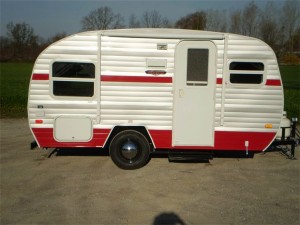 The canned ham trailers of old can be SO cute that they probably would attract as much attention as my teardrop, but most travel trailers are non-descript and white. If you want attention for your RV, then you’ll have to go with a retro canned ham (and the maintenance costs for it). Otherwise, you’ll be hard pressed to find an adorable and unique travel trailer. There are a couple of brands available today.
The canned ham trailers of old can be SO cute that they probably would attract as much attention as my teardrop, but most travel trailers are non-descript and white. If you want attention for your RV, then you’ll have to go with a retro canned ham (and the maintenance costs for it). Otherwise, you’ll be hard pressed to find an adorable and unique travel trailer. There are a couple of brands available today.
If you want to hide in obscurity, however, you can do so quite easily in a travel trailer.
As long as you don’t unhitch, you can dry camp in a Walmart parking lot. Just make sure you ask the manager if it’s alright.
I’ve never owned a travel trailer, so my viewpoint might be a little off on these RVs. They may be harder to hook up or easier to tow than I imagined. I’d be interested in using one for a few months to see how that would change my viewpoint, but at this time, I don’t have a vehicle to tow one nor the space to store it.
Here are links to the other entries in this series:
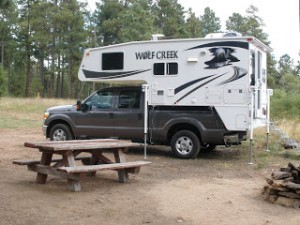 If you want the luxury of a bathroom or to be able to sleep while your partner drives, a truck camper might be your next option.
If you want the luxury of a bathroom or to be able to sleep while your partner drives, a truck camper might be your next option.
You can get a used truck camper for as little as $300 in my local classifieds. That doesn’t say it’s a good camper, but it does go to show how inexpensively you can get started, as long as you have a truck. While a cheap and good truck camper may be available for less than $2000, the truck to haul it with is NOT cheap. After looking at the current truck campers, they appear to need the biggest trucks in order to carry them. Additionally, the new campers are NOT cheap. They start out at about $18,000 and go up in cost from there. At that price, and considering you need a truck to haul them, you might as well get a travel trailer or a fifth wheel.
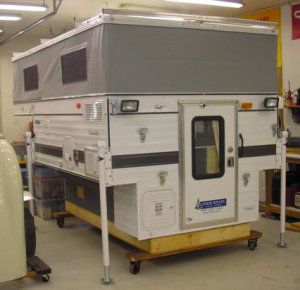 The beauty of a truck camper is that you can store it in your garage in a spot the size of one parking spot (or even smaller). You will need to make or buy a truck camper dolly (pictured to the right), in order to move it into the garage, since the camper would be WAY too high to fit under a normal garage door. If you don’t have any empty spots in your garage or on your property, you would have to pay for storage, but just like the teardrop, you might be able to negotiate a smaller fee because truck campers are so small.
The beauty of a truck camper is that you can store it in your garage in a spot the size of one parking spot (or even smaller). You will need to make or buy a truck camper dolly (pictured to the right), in order to move it into the garage, since the camper would be WAY too high to fit under a normal garage door. If you don’t have any empty spots in your garage or on your property, you would have to pay for storage, but just like the teardrop, you might be able to negotiate a smaller fee because truck campers are so small.
The best mileage you’ll be able to get out of one of those trucks is about 18 mpg with a diesel truck. That will probably fall to about 12 mpg with the camper on.
Truck campers sleep less people than a travel trailer or tent trailer, but more than you might think. They appear to only have a one bed and a dinette, but many of them have an overhead bunk that you can fold down to sleep one more. They ARE small, however, so if you have a big family, you’ll be hard pressed to sleep them all in the truck camper.
Just like the teardrop, a truck camper is hard sided and relatively small in size, so it’s easy to heat and keep warm. Some of them have propane heaters and even A/C units, so you can keep comfortable, no matter what the weather.
Additionally, there is an added comfort while you’re driving. Your children could play in the camper in the back or your spouse could sleep in the bed over the cab. Any of the passengers can use the bathroom while you continue to drive, making stops less frequent. Just like a motorhome, you can have a little freedom of movement while you’re on the road.
If you are on a long road trip, a truck camper is as good as a motorhome for ease in setup and breakdown. If you are staying for a long time in one spot, however, it is a rather involved process to take the camper off the pickup and setup at a site so you can use your truck for running errands or heading to the lake. If you’re unfamiliar with it, here is a fast-forwarded video showing the process:
There is a camper jack system that looks like it’s easier called Stable Lift. This is a little video showing how it works.
This jack systems costs an extra $2500 – $3000 and requires that you bring your camper to them for installation, but it looks like it makes camping with a truck camper much easier.
In the end, the effort to set up and break down a truck camper looks about as difficult as putting up a tent, so the truck camper might be out of the picture if you like to camp for long periods of time in one spot.
 The older units don’t tend to have bathrooms, but the new ones have bathrooms and showers, so you don’t have to take a walk in the cold in the night.
The older units don’t tend to have bathrooms, but the new ones have bathrooms and showers, so you don’t have to take a walk in the cold in the night.
Because of their high profile, truck campers are top heavy and it’s a little easier for them to flop over. You also can’t see out your rear view mirror and they usually don’t fit under drive-thrus.
Truck campers are so small that they can fit into any campsite, no matter how awkward. I don’t know if there is a prejudice against them like tent trailers, but they are very maneuverable.
I don’t know exactly how much attention a truck camper would attract. They certainly don’t have any of the cuteness that a teardrop or a canned ham would have, so I suspect you’d be safe to camp in obscurity.
Because they are fully self-contained, truck campers would be able to dry camp at a Walmart. I’ve seen them several times at our local store for overnight stays.
I’ve never owned a truck camper, so my viewpoint might be a little off on these RVs. They may be harder to drive or easier to set up than I imagined. I’d be interested in using one for a few months to see how that would change my viewpoint, but at this juncture, I don’t have a pickup to carry one.
Here are links to the other entries in this series:
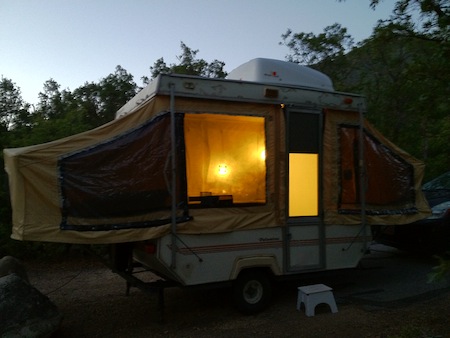 If a teardrop is too small for you, then you should look at a tent trailer next.
If a teardrop is too small for you, then you should look at a tent trailer next.
I found our first tent trailer for only $500. It only lasted us three months, but we camped for a total of two weeks in the camper, so it easily cost less than renting a similar trailer would have cost. Our current camper cost us $1000 and was a definite improvement. Buying a tent trailer new reaches the $10,000 range, but even that is less expensive than new travel trailers. Tent trailers can be towed by almost any car, so you don’t need to buy a new tow vehicle.
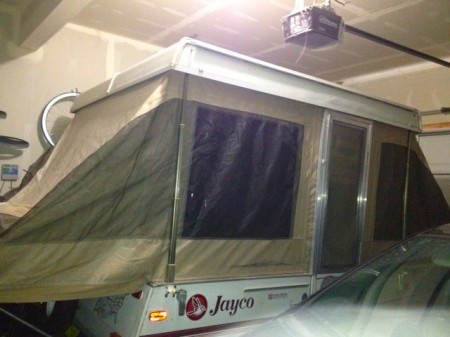 Tent trailers are small enough to roll into a garage in one parking space. I wrote about this before here:
Tent trailers are small enough to roll into a garage in one parking space. I wrote about this before here:
If you don’t have an extra spot in your garage or on your property, then you have to store it in a facility. The cost for storage at those places ranges from $65 – $100 a month.
We have chosen tent trailers that are VERY light, with no amenities like onboard water or bathrooms, so we have been able to tow them with the Prius. It only lowered our gas mileage by five miles per gallon. On our latest journey to Quartzsite and back, we averaged 29 mpg with the Prius.
Tent trailers beat the teardrop, hands down. You can EASILY sleep six people in our tiny eight foot box tent camper. Some of the larger ones even sleep 7-8 people. If you have a large family, it may be that a tent trailer is your only option.
I thought a tent camper would be as cold as a tent, which was the reason we bought the teardrop trailer, but it is warmer. I think part of the reason is the solid roof. It is definitely warmer in the living spaces than on the bunk ends. Additionally, the tent material is WAY thicker than the canvas of my Springbar tent. It appears to be covered with some sort of vinyl coating on the outside and that makes considerable improvements in the cold. There is also plenty of headroom to stand up and couches to sit on when it rains outside.
While a tent trailer is warmer than a tent, it IS colder than being in a teardrop, travel trailer or fifth wheel, especially if you don’t have a heater. Many tent trailers do have propane heaters (and even A/C units), but ours doesn’t. Instead, we use electric heaters and they work beautifully. It was 27 degrees in Las Vegas a couple of weeks ago when we were there and our little heater was able to get it to a toasty 67 degrees in our tent trailer.
My biggest problem with the tent trailer is the effort to set up and break camp. It’s not as labor intensive or time consuming as a real tent, but it DOES take some time to level out and get the roof up. We can get set up or break camp in about 20-25 minutes, which is about half the time it took us to put up our Springbar and camp kitchen, but WAY more time than it took us to get the teardrop ready.
If you are unfamiliar with the tent trailer setup, here is video describing it:
Some tent trailers even have bathroom facilities, but they are rare and the privacy tends to consist of a thin curtain. Our tiny tent trailer doesn’t have a bathroom, so we have to camp at campgrounds that have some or use our porta-potty tent. I talked about those options on these two posts:
Honestly, towing a tent trailer has been easier and safer for us than towing the teardrop. It is UNAFFECTED by strong winds and we can see over it out the rear window. It’s so easy to tow that I can’t feel it on the back of our car. Aside from a tent stuffed into the trunk of your car, the tent trailer is the safest option on this list.
A tent trailer is small and can fit in any campsite there is available, but paradoxically, we have had instances of trailer bigotry at some campgrounds. I admit that our first tent trailer, the Palomino, should have been called The Duct Tape Palace because it took so much duct tape to keep the tent fabric together, but we’ve also experienced a touch of elitism with our Jayco Eagle, even though it’s in excellent shape.
We’ve had a campground host say that she couldn’t put us in a certain spot because “everyone would see it there.” We’ve NEVER had trouble getting SOME spot with water and electricity, but somehow, certain campgrounds don’t want people to see that they have tent trailers for some reason and I never expected that sort of bigotry.
 There is NOTHING weird about a tent trailer. Even when we drove up in the Duct Tape Palace, no one gave us even a second glance. If you want people to ooh and ah over you and your RV, a tent trailer is NOT the option for you. If you want to camp in obscurity, however, people won’t even notice you and your tent camper.
There is NOTHING weird about a tent trailer. Even when we drove up in the Duct Tape Palace, no one gave us even a second glance. If you want people to ooh and ah over you and your RV, a tent trailer is NOT the option for you. If you want to camp in obscurity, however, people won’t even notice you and your tent camper.
You may, however, feel like a second class citizen in a tent trailer. That has only happened to me once, at a luxury RV resort. They saw our tiny tent trailer and were going to move us to the back of the campground, but we had made reservations to stay next to my sister, who had arrived a day earlier in her teardrop. They had put her teardrop in a premium site because it looks so cute and cool, but were reluctant to put us next to her in our tent trailer. In the end, we got the premium site, but they really made us feel like we weren’t quite good enough for their fancy RV resort.
You can see other stories of tent trailers feeling like second class citizens here:
Then again, if we had tried to stay at that resort in a real tent, they wouldn’t have let us stay at all. The bigotry we experienced being in a real tent was even worse, so having a tent trailer is definitely a step up for us.
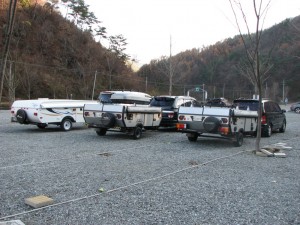 I’ve never tried to dry camp in a Walmart parking lot before, but I’ve heard through the grapevine that the managers generally say no to tent trailers. Considering that you can hear everything around you in a tent trailer, a parking lot might not be the ideal location to get some sleep.
I’ve never tried to dry camp in a Walmart parking lot before, but I’ve heard through the grapevine that the managers generally say no to tent trailers. Considering that you can hear everything around you in a tent trailer, a parking lot might not be the ideal location to get some sleep.
The forum users at Popup Portal have varied ideas about popups at a Walmart. Some of them have done it, others say it’s not safe and still others say you might as well find a campground. You can read their opinions here:
Our tent trailer doesn’t have a bathroom, a battery or a propane heater, so a stay at Walmart wouldn’t really be pleasant to us, but each person decides on their own comfort level in situations like these. It really seems to be up to each individual Walmart manager.
We have been happy with our tent trailer, so that’s where we stopped choosing, but there is a whole other world of RVs out there.
Here are links to the other entries in this series:
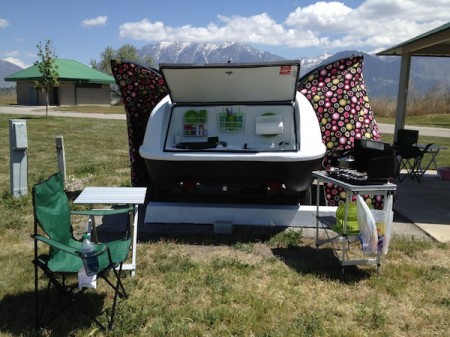 The next option available is teardrop camping. Mike and I owned a teardrop camper for a scant six months, but we took it on a cross-country trip that spanned ten states.
The next option available is teardrop camping. Mike and I owned a teardrop camper for a scant six months, but we took it on a cross-country trip that spanned ten states.
A teardrop camper can be towed by ANY car, even a Prius, so you don’t need to spend a ton of money on a huge tow vehicle. We found our teardrop trailer used for $1200, but good deals like that are few and far between. There are less teardrop trailers on the road, so there are, understandably, less teardrop trailers on the used market.
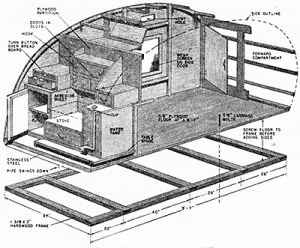 Unless you can build a teardrop yourself, they are paradoxically expensive. When I can find a good used travel trailer for about $1,200 in my local classifieds, it is crazy to me that some new teardrops cost upwards of $8,000. They are SMALLER than a travel trailer. Shouldn’t they cost LESS?!
Unless you can build a teardrop yourself, they are paradoxically expensive. When I can find a good used travel trailer for about $1,200 in my local classifieds, it is crazy to me that some new teardrops cost upwards of $8,000. They are SMALLER than a travel trailer. Shouldn’t they cost LESS?!
The teardrop is so small that it will fit in your garage in one of the spots. If you have an extra spot in your garage or on your property, then storing a teardrop won’t be a problem for you or cost you extra money. Otherwise, it can be stored at an RV storage facility, but it’s so small, you could negotiate a smaller fee than the $65 – $100 a month that RV owners usually pay for storage.
Towing a teardrop reduced our gas mileage by only five miles a gallon. We were driving a Prius, so we ended up averaging 29 mpg on our Epic Journey.
If you are a couple or out on your own, a teardrop is ideal, but the minute you add even one ten year old child, the sleeping chamber becomes a claustrophobic hell instead of a cozy den. For some, even the thought of sleeping in a tiny teardrop trailer is too cramped, but that was never a problem for us as long as Mike was able to sit up straight in the bed.
Camping in the teardrop was ideal for us. It was the first time that I had been able to sleep the night through while camping without being interrupted by strange noises or by freezing cold. We camped in that teardrop in 38 degree weather with a 20 degree windchill (making it feel like it was only 18 degrees out there), and we couldn’t feel the cold at all. If we touched the outer walls, it felt cold, but as long as we stayed away from the walls, we were toasty warm. It didn’t fair quite as well in the 112 degree weather of Southern Utah, however. Without an A/C unit, it’s impossible to escape that kind of heat.
If the weather turns bad, however, you are trapped in a small sleeping cabin, with very little room to move about. There is nowhere to change clothes, unless you create a tent-like area outside (like I did), so you are required to change in the bathrooms.
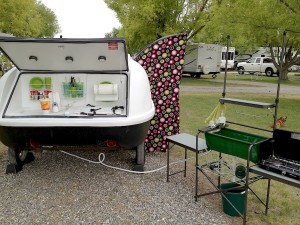 Setting up the teardrop was INSANELY easy. We would drive up, level it out, chock the tires and take the folding chairs off the bed. DONE! The camp kitchen was out back with nothing to set up but a small table for the camp stove.
Setting up the teardrop was INSANELY easy. We would drive up, level it out, chock the tires and take the folding chairs off the bed. DONE! The camp kitchen was out back with nothing to set up but a small table for the camp stove.
The strange thing is that the teardrop was so easy to set up that I started doing things to make it more complicated. Even though my teardrop had a kitchen on the back, I brought the camp kitchen that we used to use when we went tent camping on some trips because then I could use the water hookups at the campsite. This gave us a working faucet and sink, but it also complicated things more than they needed to be. The fancy teardrop trailers have sinks built into the galley, so I’m sure that one feature would be simplified with a more expensive teardrop.
There are no bathrooms in the teardrop (of course), so you have to camp at a facility that has some or create your own porta-potty tent yourself. I talked about those options on these two posts:
The teardrop was VERY easy to tow and didn’t pull on our car at all in good weather. The height of it DID block our back window, so there was that limitation, but other than that, it was almost like driving a car without a trailer attached at all.
The one time we had troubles with the teardrop was in heavy winds in Kansas. There was a wind advisory out that day, so it was an extreme example, but we could definitely feel the teardrop pulling in the wind. Of course, winds like that knock over trucks pulling fifth wheels, so the teardrop actually handled it very well.
Nothing beats a teardrop for campsite availability. It can fit into the smallest of the campsites and not one campground refused access to us. We were allowed the premium sites with water, electricity and even sewer (not that we could use it). Even campsites that were awkwardly situated weren’t a problem for us. We were able to just roll our little teardrop into place by hand. Plus, snooty campgrounds like to have unique vehicles like teardrop trailers on their property, so they will offer you premium spots just so other people will see you and think they are cool.
At first, the weirdness factor was a benefit to me. People would come up to us and ask us if we were sleeping in that tiny thing and I was delighted to show it off. After our Epic Journey, however, I had had ENOUGH. After two weeks of explaining the concept, I was DONE with talking to people about my teardrop. I just wanted people to leave me alone. If you are outgoing and love to talk to strangers, then the teardrop is perfect for you. If, however, you just want to go camping and relax in peace, a teardrop will be a definite negative.
Mike and I never tried dry camping at a Walmart in our teardrop trailer. You’d probably be fine as long as you are able to sleep in your teardrop without unhitching, because most Walmart managers insist that you don’t unhitch your trailer from your vehicle if you’re dry camping on their property. Of course, you wouldn’t have a bathroom other than the one at Walmart and you couldn’t set up your chairs because that’s another thing that’s not allowed. If, however, all you needed to do was get a few hours of sleep, then the teardrop would probably be fine in a Walmart parking lot.
I actually miss our teardrop trailer and every time I see it in my sister’s garage or they join us for camping, I get a little nostalgic for it.
Here are links to the other entries in this series:
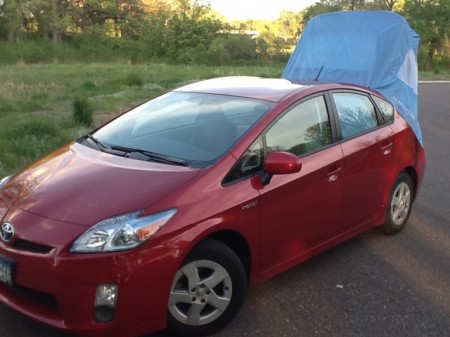 Whether you pack a tent in your car or you actually SLEEP in your vehicle, car camping is the MOST affordable.
Whether you pack a tent in your car or you actually SLEEP in your vehicle, car camping is the MOST affordable.
Car camping is cheap in gas mileage, storage and cost of gear. The most expensive tent I ever bought was $400, which is still $100 cheaper than any trailer I’ve bought.
Rather than filling up your garage, sitting outside in the rain, or costing you a monthly fee, a tent and other camping gear can be stored in a spare closet. You shouldn’t have to pay for separate storage for a tent unless you live in the smallest of apartments.
Extra tents and gear have absolutely NO impact on your gas mileage.
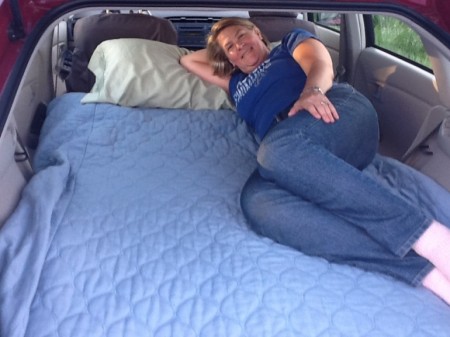 If you want to sleep IN your car, then you’re limited to two or three very cozy people. If you’re willing to sleep in tents, then you can accommodate any size of family. Your limitation is based on how many people you can fit into your vehicle.
If you want to sleep IN your car, then you’re limited to two or three very cozy people. If you’re willing to sleep in tents, then you can accommodate any size of family. Your limitation is based on how many people you can fit into your vehicle.
Camping in a tent can be COLD! Even if you have a four season tent and four season sleeping bags, you are limited to temperatures no lower than 40 degrees. Any lower and you will be truly roughing it. Additionally, it can be HOT! During the day, you will swelter if the temperature is any higher than 95 degrees. Battery powered fans and other DIY kludges can extend your camping temperatures down to 35 degrees and up to 105 degrees. For the most part, your camping time will be restricted to the best weather days if you want true comfort.
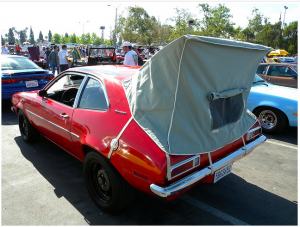 If you are sleeping IN your car, then you can extend your camping season, but then you have no place to change clothes. Additionally, it can be surprisingly uncomfortable to sleep in your car, even with an air mattress. That car roof gets mighty close to your face when you have an air mattress thick enough to make sleeping comfortable.
If you are sleeping IN your car, then you can extend your camping season, but then you have no place to change clothes. Additionally, it can be surprisingly uncomfortable to sleep in your car, even with an air mattress. That car roof gets mighty close to your face when you have an air mattress thick enough to make sleeping comfortable.
 Putting up a tent, the cots, the air mattresses, unrolling the sleeping bags and setting up the camp kitchen is a time-consuming effort. It only took us about 40-50 minutes to set up or break camp each time, but on a long road trip, that adds up to an hour and a half of hard labor each day.
Putting up a tent, the cots, the air mattresses, unrolling the sleeping bags and setting up the camp kitchen is a time-consuming effort. It only took us about 40-50 minutes to set up or break camp each time, but on a long road trip, that adds up to an hour and a half of hard labor each day.
There are no bathrooms in your car or a tent (of course), so you have to camp at a facility that has some or create your own porta-potty tent yourself. I’ve talked about those options on these two posts:
Driving a car full of camping equipment only affects the drivability of a car if you fill up the back until you can’t see out the rear window.
You can camp at any state or national state park, but many RV campgrounds won’t let you stay in their sites with electricity. When it was cold and we wanted to have an electric heater running in our tent, it was pretty near impossible to get a campground to let us stay at a site with electricity. We were willing to pay more, but they just wouldn’t let us put a tent up on their premium sites. Additionally, we couldn’t stay at any campground that was all cement or gravel because we couldn’t stake down our tent. We needed a 10’X10′ swatch of land to get our tent up (that wasn’t the case for our Hobitat, only our Springbar tent).
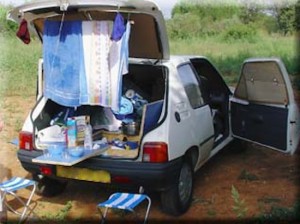 If you are camping IN your car, that is looked upon with wary by some camp hosts. I’ve actually seen a woman at a national park tell a man he had to leave his campsite after his first evening because he was “just sleeping” in his car.
If you are camping IN your car, that is looked upon with wary by some camp hosts. I’ve actually seen a woman at a national park tell a man he had to leave his campsite after his first evening because he was “just sleeping” in his car.
The only time I ever had a stranger talk to me about my tent was on an extremely cold morning after and even colder night. He said, “You musta froze last night.” We were pretty much ignored when we went tent camping.
If you asked permission to put up a tent on the Walmart parking lot, I’m pretty sure the manager would laugh you right out of the store. If, however, you asked if it was alright if you slept in your car, you might be allowed or might also be looked at like you’re a homeless wastrel. Of course, there is always the option of stealth camping if you’re sleeping in your car.
In the end, the cold did us in. It’s particularly frigid in the Utah mountains, even in the summer, so we ended up leaving the car camping behind.
Here are links to the other entries in this series:
Powered by WordPress
(c) 2005-2017 Michael Moncur, Laura Moncur, and Starling Studios